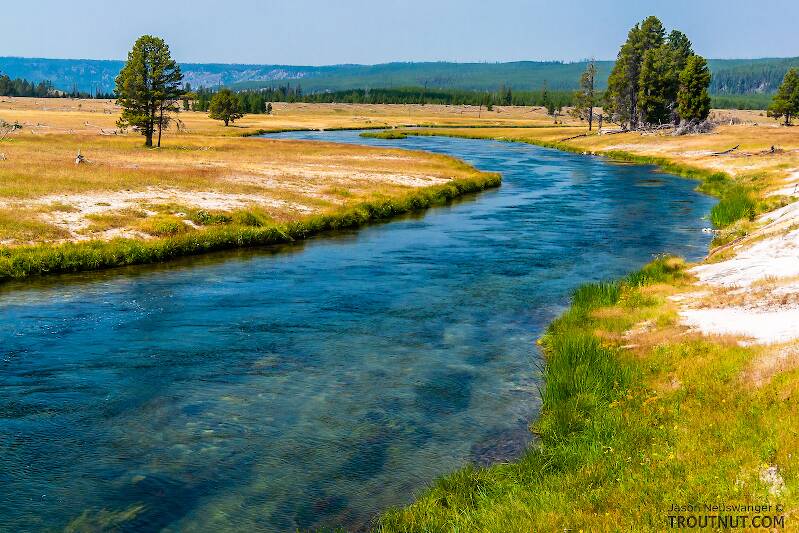
Salmonflies
Pteronarcys californica
The giant Salmonflies of the Western mountains are legendary for their proclivity to elicit consistent dry-fly action and ferocious strikes.


Stonefly Species Isoperla pinta (Yellow Sallies)
Species Range
Identification
Species ID from GBIFthe Global Biodiversity Information Facility
Source: The Isoperla Of California (Plecoptera: Perlodidae); Larval Descriptions And A Key To 17 Western Nearctic Species
Diagnosis. The male larvae of Isoperla pinta are distinct among other western Isoperla species with 2 – 4 submarginal setae (A + B). The 1 – 2 submarginal setae (A) are less than half as stout at their base than the largest marginal setae (C) and lack or possess weak longitudinal striations (Figs. 14 g-h).
Physical description
Most physical descriptions on Troutnut are direct or slightly edited quotes from the original scientific sources describing or updating the species, although there may be errors in copying them to this website. Such descriptions aren't always definitive, because species often turn out to be more variable than the original describers observed. In some cases, only a single specimen was described! However, they are useful starting points.
Description from GBIFthe Global Biodiversity Information Facility
Source: The Isoperla Of California (Plecoptera: Perlodidae); Larval Descriptions And A Key To 17 Western Nearctic Species
Male larva. Body length of mature larva 10 – 13 mm. Dorsum of head with contrasting pigment pattern and fine light and dark clothing setae, anterior frontoclypeus margin unpigmented; light M shaped pattern anterior to median ocellus not typical of western Isoperla species, usually connected to light frontoclypeus area by thin median longitudinal light band, lateral arms distinctly swollen at approximately mid length, usually directed laterally, extending to above antennal bases; posterior ocelli with partially enclosed large light areas along outer lateral margins; interocellar area partially light, an irregular shape enclosed by dark brown pigment anteriorly and light brown pigment posteriorly; occiput with irregular spinulae band extending from below eye to near median epicranial suture, not enclosed completely by dark pigment (Fig. 14 a). Lacinia bidentate, total length 682 – 841 µm (Figs. 2 L, 14 e-h, Tables 2 - 4); submarginal row (A + B) with 4 – 5 setae, groups A-B interrupted by gap below subapical tooth (SAT) inner margin (Figs. 14 g-h); 1 – 2 submarginal setae (A) the first inserted at base of apical tooth (AT) inner margin, the second when present, located between AT and SAT inner margins, first seta half as stout at base as marginal setae (C) and longitudinal striations weak or absent, all other species first seta nearly as stout and with striations, plus 1 thin marginal seta (TMS) adjacent to AT inner margin, sometimes obstructed from view by AT or broken, and 1 dorsal seta (DS) located below SAT inner margin, partially obstructed by SAT or first submarginal setae (B) (Figs. 14 g-h); 2 – 3 submarginal setae (B) located past SAT inner margin (Fig. 14 h); 4 – 7 marginal setae (C), initially long-stout and widely spaced, last few shorter and variably spaced, blending into and difficult to differentiate from dorsal setae (Fig. 14 e); 29 – 50 ventral surface setae (D) forming dense longitudinal band below marginal setae, ending posteriorly at approximately ¾ the inner lacinia margin length, and concentrated in posterior half (Fig. 14 f); dorsal surface setae (DSS) forming dense, laterally protruding, longitudinal band on and along inner-lateral margin, ending before posterior-most ventral surface setae (Fig. 14 f). Galea with 8 – 17 setae in sparse ventral row, apex with 4 setae. Maxillary Palp segments 2 – 3 with curved, apically rounded setae. Pronotum with irregular shaped median light area bordered by complex pattern of dark markings; discs each with distinctive lateral dark checkerboard pattern, fine dark and light clothing setae and lateral margins with broad light bands (Fig. 14 b). Mesonotum and metanotum with contrasting pigment pattern and fine dark and light clothing setae (Fig. 14 c). Legs with numerous light and dark clothing setae and scattered erect spines on outer surface of femora, erect spines longest and concentrated along dorsal surface; fine silky setae numerous and continuous on dorsal surfaces of femora and tibia (Fig. 20 L); distal femur and proximal tibia with transverse bands. Abdominal terga with three distinct longitudinal stripes and small dark spots arranged in pairs on dorsal surface and in triplets laterally; wide light median longitudinal band bisected with irregular shaped dark median stripe; lateral pair of dark longitudinal stripes about as wide as median dark stripe, not extending to lateral margins; numerous fine light clothing setae and erect spines scattered dorsally; posterior margin with scattered long and numerous short spines in a concentrated row (Fig. 14 d).
Source: The Isoperla Of California (Plecoptera: Perlodidae); Updated Male Descriptions And Adult Keys For 18 Western Nearctic Species
Male. Aedeagus: sclerotized posterior process absent; body with one posterobasal lobe, one small posteroapical lobe, and a pair of anterolateral lobes (Fig. 11 a); Mesoposterior area of ninth tergum with bipartite patches of long fine light spinulae mixed with patches of long clear setae (best viewed from lateral angle). Posterolateral margins of at least abdominal segment 8 with scale-like setae clustered in brushes of several setae. Paraprocts: curved dorsally, length if straightened subequal to combined first and second cercal segments, tapering abruptly to blunt apices (Fig. 11 c) apices usually secondarily barbed along ventral margin. Vesicle: rounded lobe, widest at base with broadly rounded apical margin (Fig. 11 d).
Start a Discussion of Isoperla pinta
Stonefly Species Isoperla pinta (Yellow Sallies)
Species Range
Common Names
Resources
- NatureServe
- Integrated Taxonomic Information System
- Global Biodiversity Information Facility
- Described by Frison, T.H. (1937) II. Descriptions of Plecoptera with special reference to the Illinois Species. Illinois Natural History Survey Bulletin 21, 78–99.

